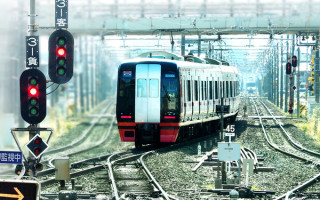Security Solution for Tomorrow’s Railway Applications
September 01, 2021
Story

Vision systems for rail applications can serve many purposes, from the very mundane to those that can protect passengers. The obvious uses are to constantly monitor tracks to ensure that the railways remain clear of obstructions and to ensure that trains are where they are supposed to be at any given time.
Lately, such systems have been deployed to make sure that people are in the places they are supposed to be, to ensure that no unnecessary injuries occur. In some cases, the surveillance systems can monitor the heath of the trains themselves, ensuring that they are intact, not overheating, and so on.
Before such surveillance systems were available, various other methods were employed to handle the basic tasks, including manually watching out for potential failures, but nothing was nearly as accurate as today’s modern vision systems. In those existing systems, many of the sensors are connected via USB, resulting in unstable communications due to the introduction of noise. More stability can be found in a system that employs an RS-232 connection, particularly when multiple connections are required.
Challenges Abound in Rail Security Solutions
As you might expect, developers will encounter a series of challenges when designing a system aimed at surveillance for rail applications. The first challenge is knowing what to surveil, and the second is understanding what hardware and software is needed to ensure that the proper actions are taken at the appropriate times.

Another key consideration is that the environment that such a system must live in is far from ideal. In some cases, the system, or at least some of its components, may be permanently outdoors, and could be subject to wide temperature swings. And in other cases, the system may be subject to lots of shock and vibration as part of a moving train. Finally, systems aimed at rail applications tend to be in use for many years. As a result, it’s important to ensure longevity, potentially beyond five or ten years.
On a more technical level, current railroad crossing monitoring systems are generally based on an ARM Coretex-A7 CPU, with a Power-over-Ethernet (PoE) switch, a router and other components with disparate configurations. Hence, they can be complex to build, expensive to maintain, and difficult to upgrade. More modern, compact solutions are available that greatly reduce the setup and maintenance costs, especially over time. Another issue to be dealt with is that the power supply voltage used at most railroad crossings is quite high and not very reliable.
Compact All-In-One Systems
The optimal solution for an all-in-one compact system for railroad surveillance would provide fanless operation in the -40°C to +75°C temperature range, such as the Vecow SPC-4600 ultra-compact embedded PC. In fact, such a system is already in operation in one of Japan’s busier terminals. The platform is developed around a low-power, quad-core Intel Atom E3950 SoC (Apollo Lake-I). Other features of the system include DVI-I and DisplayPort dual-display support for up to 4K resolution, up to 8 Gbytes of DDR3L, 1.866-GHz memory, dual GigE PoE+ LAN interfaces, and a host of other I/O. Input voltage can range from 9 to 36 V.

In many systems, including those already deployed in railway surveillance applications, the current measured at the digital input (DI) port could be as weak as 2 mA. A reading near 10 mA is more desirable, and that’s what is available with the Vecow SPC-4600. To design in a PoE camera, dual PoE is a minimum level of acceptance, and IEEE 802.3af or above is preferred. These are standard features on the SPC-4600. In addition, Mini PCIe sockets for PCIe/USB/SIM cards are used to compensate for the potentially unstable LTE signal, while an external SIM socket makes it easier to manage the WiFi/4G/3G/LTE/GPRS/UMTS wireless connection.
We’ve outlined the high points here, showing what an engineer can expect when he or she works with Vecow on platforms aimed at railway surveillance applications. Vecow’s product differentiation should be obvious, from the choice of the latest Intel CPUs, to the memory and I/O, to the security features that are baked into the platform, all designed for railway surveillance environments.
Vecow is willing to customize its platforms for specific applications, making sure that the necessary features are included (and unnecessary features are eliminated), so the end customer only pays for the hardware and software components needed. Fine tuning those components is one of the keys to working with a partner with the right expertise.
Products Included in the Roadmap to Success
Some of the latest products from Vecow include the AIC-100 intelligent automation controller. It’s designed with an industrial-grade NXP i.MX6ULL Arm Cortex-A7 processor, a 9- to 50-V input voltage range, and all the necessary I/O, including two LAN, one USB 2.0, and two COM RS-232/485 ports, and Mini PCIe with a SIM socket for 4G/LTE/WiFi/BT/GPRS/UMTS. The compact and cableless design boasts a low power consumption.
Rounding out the offerings is the ABP-3000, which lives at the high end, with its ability to control autonomous mobile robots (AMRs) and perform the operations needed for machine vision applications. These features are made possible thanks to the inclusion of an 8th Generation Intel Core U-series processor (Whiskey Lake) and compact Hailo-8 AI accelerator that supports up to 26 TOPS with best-in-class power efficiency of 3 TOPS/W. Offered as an option, the VHub One-Stop AIoT solution service supports an OpenVINO-based AI accelerator and advanced Edge AI applications.




